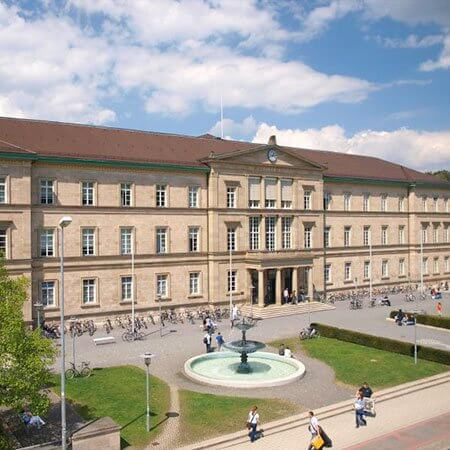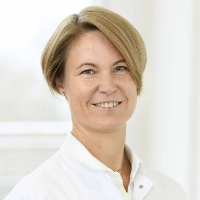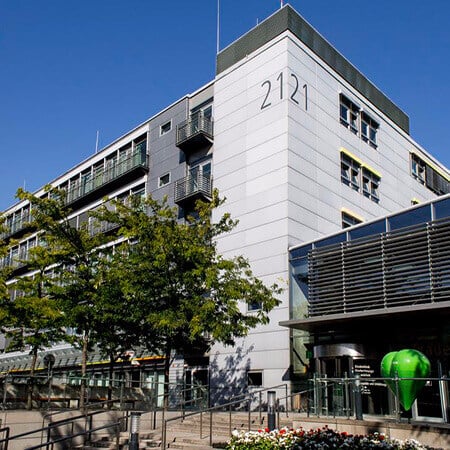Remains of Embryonic Tissue and Fetal Membranes — Therapeutic Curettage Under Control Hysteroscopy: treatment in the Best Hospitals in the World
Treatment prices are regulated by national law of the corresponding countries, but can also include additional hospital coefficients. In order to receive the individual cost calculation, please send us the request and medical records.

Department of Adult and Pediatric Gynecology, Mammology, Obstetrics
According to the Focus magazine, the Department of Adult and Pediatric Gynecology, Mammology, Obstetrics is included in the ranking of the top German departments specializing in obstetrics and breast cancer treatment! The department offers the full range of diagnostics and treatment of diseases of the female reproductive system, breast pathologies. Also, the specialists of the department provide a comprehensive management of pregnancy, childbirth and postpartum care for both mother and child. Key attention is paid to the treatment of female genital cancers, as well as breast cancer treatment. For this purpose, the department has all the modern therapeutic techniques, as well as its our own innovative developments by the department doctors.







Department of Adult and Pediatric Gynecology, Mammology, Obstetrics
The Department of Adult and Pediatric Gynecology, Mammology, Obstetrics offers high-precision diagnostics and effective treatment of the full range of diseases of the female reproductive system and breast pathologies. The medical facility also employs a competent team of obstetricians, whose responsibilities include comprehensive management of pregnancy, childbirth, and postnatal care for mother and baby. More than 3,000 babies are born in the department's delivery rooms annually. The department cooperates closely with the UniFee Reproductive Medicine Center, which allows gynecologists to treat female infertility together with reproductive medicine specialists. The department's gynecologists focus on women with reproductive system cancers. The medical facility is certified by the German Cancer Society (DKG) as a specialized center. The specialists also successfully treat endometriosis, one of the most common benign gynecologic diseases. In the field of mammology, priority is given to the provision of medical care to women with breast cancer. Doctors perform comprehensive diagnostics, surgical and conservative treatment, and reconstructive plastic surgery after mastectomy. The department's specialists use state-of-the-art technical resources and their professional skills to provide each patient with high-quality medical service.







Department of Adult and Pediatric Gynecology, Mammology, Obstetrics and Reproductive Medicine
The Department of Adult and Pediatric Gynecology, Mammology, Obstetrics and Reproductive Medicine offers the full range of surgical and conservative treatment of pathologies of the female reproductive system, breast, as well as top-class obstetric services, including management of birth and postnatal care for both mother and baby. The department also has a Center for Reproductive Medicine, where one can undergo comprehensive diagnostics to detect the causes of infertility and use modern assisted reproductive technologies. The department's excellent technical equipment, highly qualified medical staff and the availability of advanced treatment methods allow providing optimal and individualized treatment at the highest level. The treatment of female reproductive cancers is of primary interest to the department's gynecologists. The department also admits girls and young women with congenital anomalies of the genital organs, menstrual disorders, delayed or premature puberty.






Remains of embryonic tissue and fetal membranes are detected in 3% of women after medical abortion. The longer the gestational age, the higher the likelihood of preserving the remnants of the fetal egg. If it is partially preserved in the uterus, it has to be removed using an invasive procedure. In Germany, treatment is carried out under hysteroscopic guidance. Doctors insert a thin tube with a video camera and instruments into the uterus through the vagina to visually monitor the process and reduce the risk of complications to almost zero.
Content
The remaining tissue can be safely removed from the uterus using vacuum aspiration or endometrial curettage under hysteroscopy guidance.
You can undergo your treatment at the University Hospital Tuebingen, the University Hospital Ulm, or the University Hospital Carl Gustav Carus Dresden.
Booking Health will take care of the arrangements for your trip. We will help you to choose a highly specialized clinic and a doctor, arrange an urgent appointment, help you to prepare medical documents and apply for a visa, arrange your flight and accommodation, and provide interpreting services. A personal medical coordinator will constantly be in touch with you during your treatment.
Diagnostics
Women with the remains of a fetal egg in their uterus come to a doctor with the following symptoms: lower abdominal pain, fever, and intense spotting.
A clinical examination and an ultrasound scan are sufficient to diagnose the remains of the fetal egg. A gynecological examination determines uterine softness and pain.
With the help of an ultrasound scan, the doctor can see the expansion of the uterine cavity by more than 10 mm, as well as the heterogeneity of the endometrium due to inclusions with increased and decreased echogenicity. A patient has increased blood flow.
Laboratory tests help doctors to make a diagnosis. Women have elevated beta-hCG levels.
Conservative therapy
Not all women with fetal egg remains require invasive treatment. In some cases, "hormonal curettage" may work. Doctors prescribe hormones that stimulate the natural release of the remains of embryonic tissue and fetal membranes. Progestogens are used, which are prescribed from the 16th to the 25th day from the onset of spotting.
The remains of the fetal egg are dead tissues, so they may cause inflammatory complications. To avoid the joining of a bacterial infection with the development of endometritis, a patient is prescribed antibiotics.
In the absence of any signs of infection and bleeding, a woman is prescribed drugs to stimulate her uterine contractility, which contributes to the remains of the fetal egg coming out of the reproductive system.
Vacuum aspiration
If conservative therapy is ineffective or unpromising, doctors perform vacuum aspiration of the remains of the fetal egg. This procedure is also called a mini-abortion. It is usually carried out to terminate a pregnancy at a short time, optimally, up to 6 weeks.
Vacuum aspiration can also be performed in the presence of remains of the fetal egg, since their volume is usually minimal. This is a non-traumatic and safe procedure that is performed on an outpatient basis and does not require any rehabilitation.
Doctors use a special device that creates negative pressure. A plastic cannula is inserted into the uterus. It has a small diameter, so there is no need to dilate the cervix. With the help of an aspirator, the remains of fetal tissue are aspirated and removed from the uterus.
After the procedure, an ultrasound scan is conducted to make sure that there are no remnants of the fetal egg. Whenever required, a woman may be prescribed antibiotics to prevent infectious complications. Hormonal drugs can also be prescribed.
Curettage
Uterine curettage involves the removal of the functional layer of the endometrium along with the remains of the fetal egg. This is the most efficient and reliable procedure. It is successful even in the case of a large amount of tissue remaining in the uterus.
The procedure is performed under general anesthesia. A doctor dilates the cervical canal and removes endometrial tissue with a curette. In the classic version, this procedure is performed blindly, that is, the doctor does not see anything but focuses solely on tactile sensations. This method of curettage increases the risk of complications such as uterine perforation, damage to the basal layer of the uterine endometrium, the formation of intrauterine synechiae, and infertility.
The hysteroscopy treatment is safer. Doctors in German hospitals control their actions visually, so they do not damage tissues and remove the remains of the fetal egg without any health consequences.
You can undergo your treatment of the remains of fetal tissue in the uterus at one of the German clinics. The Booking Health website presents the cost of medical services in different centers. You can compare prices and choose the one that suits you best. Our specialists will help you to make the best choice and arrange your trip.
Authors:
The article was edited by medical experts, board-certified doctors Dr. Vadim Zhiliuk and Dr. Sergey Pashchenko. For the treatment of the conditions referred to in the article, you must consult a doctor; the information in the article is not intended for self-medication!
Sources:

